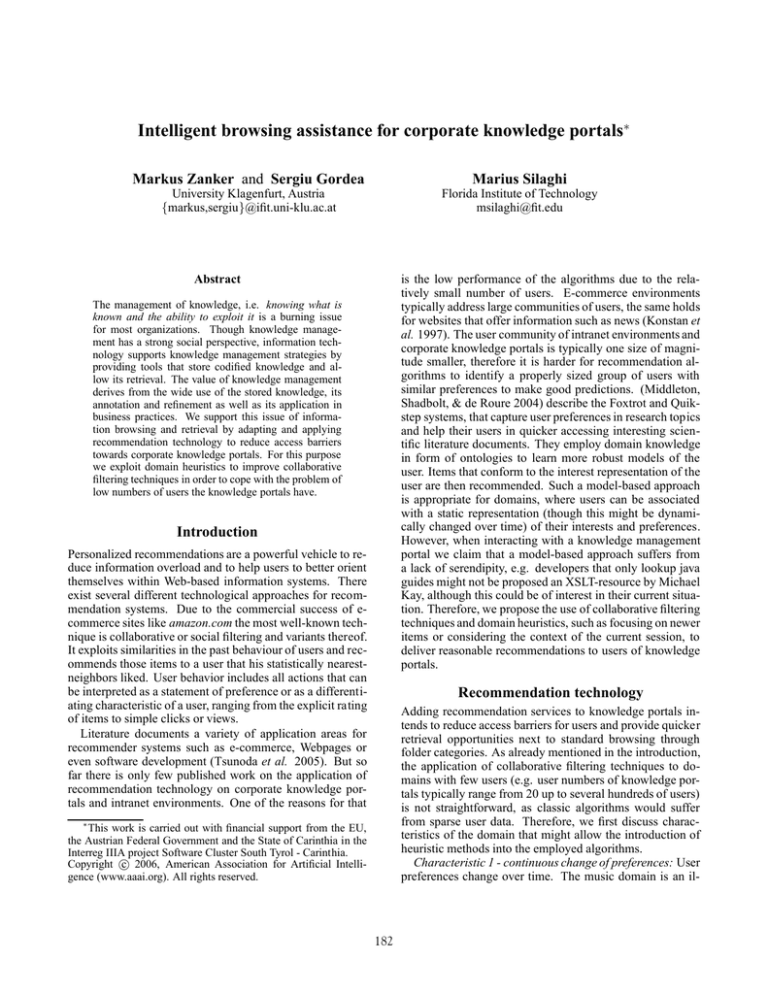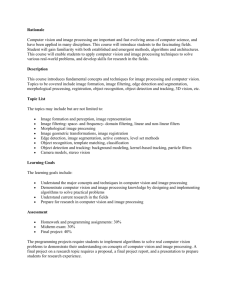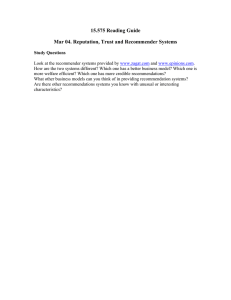
Intelligent browsing assistance for corporate knowledge portals∗
Markus Zanker and Sergiu Gordea
Marius Silaghi
University Klagenfurt, Austria
{markus,sergiu}@ifit.uni-klu.ac.at
Florida Institute of Technology
msilaghi@fit.edu
is the low performance of the algorithms due to the relatively small number of users. E-commerce environments
typically address large communities of users, the same holds
for websites that offer information such as news (Konstan et
al. 1997). The user community of intranet environments and
corporate knowledge portals is typically one size of magnitude smaller, therefore it is harder for recommendation algorithms to identify a properly sized group of users with
similar preferences to make good predictions. (Middleton,
Shadbolt, & de Roure 2004) describe the Foxtrot and Quikstep systems, that capture user preferences in research topics
and help their users in quicker accessing interesting scientific literature documents. They employ domain knowledge
in form of ontologies to learn more robust models of the
user. Items that conform to the interest representation of the
user are then recommended. Such a model-based approach
is appropriate for domains, where users can be associated
with a static representation (though this might be dynamically changed over time) of their interests and preferences.
However, when interacting with a knowledge management
portal we claim that a model-based approach suffers from
a lack of serendipity, e.g. developers that only lookup java
guides might not be proposed an XSLT-resource by Michael
Kay, although this could be of interest in their current situation. Therefore, we propose the use of collaborative filtering
techniques and domain heuristics, such as focusing on newer
items or considering the context of the current session, to
deliver reasonable recommendations to users of knowledge
portals.
Abstract
The management of knowledge, i.e. knowing what is
known and the ability to exploit it is a burning issue
for most organizations. Though knowledge management has a strong social perspective, information technology supports knowledge management strategies by
providing tools that store codified knowledge and allow its retrieval. The value of knowledge management
derives from the wide use of the stored knowledge, its
annotation and refinement as well as its application in
business practices. We support this issue of information browsing and retrieval by adapting and applying
recommendation technology to reduce access barriers
towards corporate knowledge portals. For this purpose
we exploit domain heuristics to improve collaborative
filtering techniques in order to cope with the problem of
low numbers of users the knowledge portals have.
Introduction
Personalized recommendations are a powerful vehicle to reduce information overload and to help users to better orient
themselves within Web-based information systems. There
exist several different technological approaches for recommendation systems. Due to the commercial success of ecommerce sites like amazon.com the most well-known technique is collaborative or social filtering and variants thereof.
It exploits similarities in the past behaviour of users and recommends those items to a user that his statistically nearestneighbors liked. User behavior includes all actions that can
be interpreted as a statement of preference or as a differentiating characteristic of a user, ranging from the explicit rating
of items to simple clicks or views.
Literature documents a variety of application areas for
recommender systems such as e-commerce, Webpages or
even software development (Tsunoda et al. 2005). But so
far there is only few published work on the application of
recommendation technology on corporate knowledge portals and intranet environments. One of the reasons for that
Recommendation technology
Adding recommendation services to knowledge portals intends to reduce access barriers for users and provide quicker
retrieval opportunities next to standard browsing through
folder categories. As already mentioned in the introduction,
the application of collaborative filtering techniques to domains with few users (e.g. user numbers of knowledge portals typically range from 20 up to several hundreds of users)
is not straightforward, as classic algorithms would suffer
from sparse user data. Therefore, we first discuss characteristics of the domain that might allow the introduction of
heuristic methods into the employed algorithms.
Characteristic 1 - continuous change of preferences: User
preferences change over time. The music domain is an il-
∗
This work is carried out with financial support from the EU,
the Austrian Federal Government and the State of Carinthia in the
Interreg IIIA project Software Cluster South Tyrol - Carinthia.
c 2006, American Association for Artificial IntelliCopyright gence (www.aaai.org). All rights reserved.
182
lustrative example. Different trends (folk, rock, pop, house
etc.) dominate the market for some period of time, but also
special events influence users interest at short notice. This
motivates us to introduce time frames to determine user preferences.
Characteristic 2 - different user groups: Users of knowledge portals can be differentiated according to their status and user type on the meta-level, e.g. system administrators, higher-level management staff and regular employees. When analyzing logs of different knowledge management systems we identified different user groups that distinguish themselves by a fundamentally different behaviour,
e.g. administrators mainly add knowledge items to the system while regular employees are basically consumers.
Characteristic 3 - user intention: Users have a specific
intention that might change between each session with the
knowledge portal, that overrule their more stable general interests and preferences, i.e. within the context of a specific
session or visit users are interested in a particular type of information. Therefore, we have to consider the current context of a user making a recommendation. We use for example the browsing behaviour into different folders as an
indicator for his intentions and can therefore make contextdependent recommendations to him.
Characteristic 4 - novelty: Users of knowledge portals
have a higher interest in new and currently added items. This
demonstrates itself in the daily access rates of knowledge
objects. The access typically peaks shortly after the object’s
creation date. In our experimental evaluation we observed
that half of all accesses happened within the first month after
creation.
We accommodate this domain characteristic weighting
the degree of novelty into the ranking function:
PN
scoreik = h(t) ∗ N1 ∗ j=1 simij ∗ rjk ,
acci
h(t) = 1+ 11 ∗t , DINi = acct
,
i
recommendation process by analysing the effectiveness of 5
different recommender algorithms: topn, topncf, cftime, cfcontext and cfcontexttime. The topn algorithm recommends
the best rated n items, where n is the number of items accessed by the active user in the period of time considered for
evaluation. Topncf algorithm recommends the best ranked
n items, rated by members of user neighborhood. The last
three collaborative filtering (CF) algorithms use additional
time and context constraints to reduce the number of elements in the list of recommended items without eliminating
any of the candidate items. From the total of 57 users, we
were able to identify 17( 30%) with a consistent activity and
user neighborhood for which we computed the recommendations. The evaluation of the algorithms was done with
the help of precision, recall and F1 metrics (Herlocker et al.
2004). The top n algorithms have a poor performance showing that they are not designed to work under such restrictive
conditions. The cfcontext presents a higher precision with
the expense of a low recall, while the cftimecontext algorithm slightly improves the performance of cftime algorithm
presenting the best performance with respect with all metrics
(with an average of: F1=0.32, Precision=0.46, Recall=0.32),
being also the algorithm with the lowest variance of the metrics computed over all predictions.
Conclusions
We presented our approach to improve the usability of intranet portals by using recommendation technology. We use
a set of heuristics with respect to the use of knowledge portals in order to improve the effectiveness of the recommendation algorithms. Five different algorithm approaches were
taken into account to evaluate the benefit of using time and
context based heuristics. We can conclude that both time and
context improved the effectiveness of the algorithms with respect to Precision, Recall and F1 metrics.
We introduced an enhanced scoring and rating functions that
produced an advanced ranking of recommended items and
overcomes problems of few users.
DINi
where rjkt is the the user’s j rating for item k, acci represents the number of distinct items accessed by user i, and
accti is the total number of item accesses of user i. The
item’s age is used in an attenuation function h(t) that reduces
the weight of older items in the scoring function.
Collaborative filtering algorithms depend on the availability of item ratings, used to identify user’s preferences.
Therefore we use normalized implicit ratings computed as:
rateik = 1 − αe−accik , where rateik is the rating of user
i for item k, accik is the number of times user i accessed
item k, and α is the coefficient used to adjust the function’s
attenuation.
References
Herlocker, J.; Konstan, J.; Terveen, L.; and Riedl, J. 2004.
Evaluating collaborative filtering recommender systems.
ACM Transactions on Information Systems 22(1):5–53.
Konstan, J.; Miller, B.; Maltz, D.; Herlocker, J.; Gordon,
L.; and Riedl, J. 1997. Grouplens: Applying collaborative filtering to usenet news. Communications of the ACM
3(40):77–87.
Middleton, S. E.; Shadbolt, N. R.; and de Roure, D. C.
2004. Ontological user profiling in recommender systems.
ACM Transactions on Information Systems 22(1):54–88.
Tsunoda, M.; Kakimoto, T.; Ohsugi, N.; Monden, A.;
and Matsumoto, K. 2005. Javawock: A Java Class
Recommender System Based on Collaborative Filtering.
In 17th International conference on Software Engineering
and Knowledge Engineering (SEKE’05). ACM.
Evaluation
For evaluation we employ system logs of a productive
knowledge management system, collected over a period of
10 months. The system contains 206 knowledge objects
placed in 115 different folders (i.e. categories). The logs
from the first 6 months were used to compute the user to user
similarities, using Pearson correlation, while the log data
from the last 4 months was used to evaluate the effectiveness
of the recommendation algorithms. We evaluated the influence of introducing time and context based constraints in the
183


